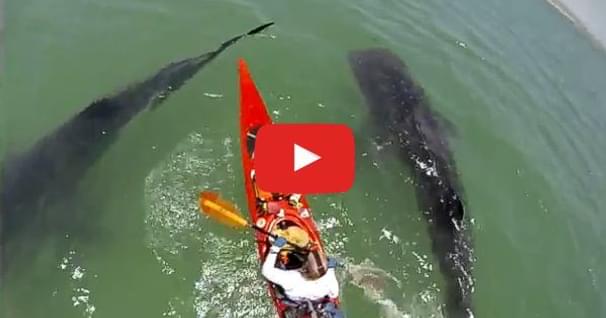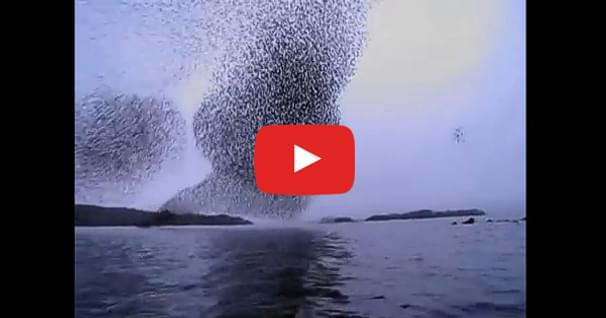Wildlife Encounters on the Water
"Eager to catch up and excited to begin the river journey, I pushed off into the river - and then was startled almost out of my wits by the sudden violent splashing of a huge bull hippo bobbing to the surface, blowing and snorting, forcing me to swerve close to the papyrus to dodge him. My private opinion that an unmolested hippo was not dangerous to man was refuted when this great barrel-shaped hulk plunged after me in a vicious charge that left no doubt as to his intentions. He was nearly as long as my kayak and must have weighed well over three tons, yet his rage drove him through the water at an incredible speed. His nostrils blasted spray with every snort, and his yellow tusks were, to say the least, awesome... My frail kayak seemed ridiculously vulnerable."
As the above quote from John Goddard's 1979 book, "Kayaks Down the Nile," makes clear, wild animals are far from a laughing matter when you're out on the water. His voyage down the longest river in the world was filled with many such experiences, but that hippo certainly left an impression on Goddard, and instilled a quiet fear in the thousands of paddlers who have read his account in gape-jawed horror since.
All too often, boaters get into trouble by coming too close to, startling, or otherwise "experiencing" a wild animal while out on the water or in camp. Others, carelessly paddling near sensitive areas, damage habitats and disrupt wildlife with their curiosity.
But the fact of the matter is, up close and personal wildlife encounters are one of the reasons many of us take up paddling in the first place. You just don't get many opportunities to see a blue heron, or a whale, in its natural habitat while on land experiences that a kayak makes possible.
But, done haphazardly, wildlife viewing can be a dangerous and destructive activity, both for the paddler and for the animals involved. The good news is there are safe ways to go about it, but it's important to follow the guidelines set up by the National Parks Service and other resource managers to ensure that (1) you don't get in over your head, and (2) the wildlife remain happy and healthy for others to enjoy down the road.
Brian Collen with Pacific Northwest Expeditions Ltd. in Vancouver Island, BC says that the problem is often just a lack of information.
"Many people think that just because they're paddling a kayak they're being unobtrusive," he says, "but, in fact, the opposite is true. Small boats are very obtrusive. They are relatively quiet, so they can sneak up on and startle animals, and they can also glide close to the shoreline, near many nesting sites."
Collen's guides follow what he calls "responsible wildlife viewing practices:" researching the wildlife they'll likely come across before heading out, reviewing local guidelines, keeping their distance when they do see something, and learning about normal behaviors so they'll be able to recognize signs of disturbance.
Bruce Connery, with Maine's Acadia National Park, suggests boaters take the following points into consideration when paddling near islands, shores, and wildlife.
- Make a plan before you head out to the water and try to learn as much as possible about the area you want to visit. This would include closure schedules ("wildlife nesting or haul-out sites, etc..."), property boundaries, and potentially threatening situations. Also, adhere to common sense rules: pack out your waste, know your limitations, don't litter, and always prepare for the unexpected.
- Observe buffer zone areas established around wildlife sites and plan your travel course to avoid getting too close to them.
- Avoid paddling directly toward a closed area, even if you are located outside the buffer area. You may know that you are going to turn, but the animals inside won't know that and may flush from the area, leaving juveniles unattended or disrupting normal feeding schedules. "Remember, one instance may be a turning point regarding the health or well-being of [these animals], and because paddlers commonly [the same] access points, it is likely that many incidents will occur. It is the cumulative effect that causes real havoc with wildlife."
- Avoid motions or noises that might attract animals. It might allow you a closer look or an interesting experience, but more likely you'll end up startling the animal and causing more of disruption than you would have otherwise.
- If you encounter an animal be quiet, move slowly, and avoid quick motions. Turn your bow away as you watch aiming your boat directly at them may appear aggressive or threatening.
- Respect animals and their activities. For example, if you happen on seals or otters that are foraging, keep your distance, observe briefly, and turn around so as not to disturb them.
Linda Welch, a wildlife biologist with the Petit Manan National Wildlife Refuge who specializes in seabird restoration, agrees with the need for pre-trip research, stressing the impact that seemingly harmless paddling can have on the fragile ecosystems she monitors along the Maine coast. "Learn which islands support nesting birds and avoid them during the nesting season," she says. Recognize that birds flying over an island or ledge may indicate nesting activity, and this area should be avoided. Most adult seabirds will fly up from their nests in response to humans landing on an island but even a brief event may allow gulls to eliminate much of the productivity for that year."
And care is equally important when off the water, something that Steve Lentz, a guide with over 15-years experience in the Yellowstone backcountry, knows all too well.
"We have awoken to tracks," he says. "And once while paddling away from a camp we turned to see a grizzly finishing a 2-mile swim across the lake, making a beeline to what had been the beach we had breakfast on."
But in all that time, Lentz has never had to face down a higher member of the food chain, thanks in large part to the preparation work he does before every trip, and the precautions that his guides take while in country keeping away from known nesting sites, encouraging "chatter" so that animals can hear them coming, taking standard preventative measures while in camp (cleaning thoroughly, leaving no waste, storing all "bait" up and away from the tents) and keeping their impact to a minimum.
When in doubt, check with the rangers or guides in the area you'll be paddling to see what they recommend in regards to the local wildlife.
Tim Sprinkle is a freelance writer whose work has appeared in Seakayaker, Paddler, and other publications.
Related Articles
Wildlife viewing, particularly birding, is an extremely popular activity among paddlers. The shallow…
The Sea of Cortez in Baja California, Mexico is an amazing paddling destination. Encounters with its…
Two girls canoeing the River Shannon in Ireland witness one of nature's most amazing phenomenon: a huge…


